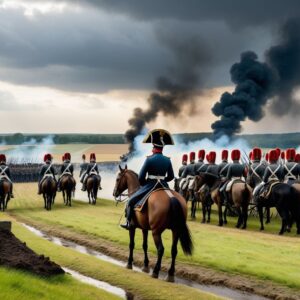June 18, 1815, was a day etched forever in the annals of history—a day when the fate of Europe hung in the balance. The rolling fields near the small Belgian village of Waterloo became the stage for one of the most pivotal battles of all time, a clash that would mark the end of an era and reshape the continent forever. This was Napoleon Bonaparte’s last stand, a moment charged with tension, strategy, and the hopes of a desperate Europe.
Napoleon, once a revolutionary hero who had crowned himself Emperor of the French, had risen to dominate much of Europe through his brilliant military campaigns. But after escaping exile on Elba, he returned to power in what would be known as the Hundred Days, threatening the fragile balance of European nations determined to stop him. The Allied forces—primarily British, Dutch, Belgian, and Prussian troops—gathered to confront him in this decisive battle.
The morning of June 18 was tense. Thick clouds hung low over the battlefield, turning the muddy terrain treacherous for soldiers and horses alike. Napoleon, known for his bold tactics, faced an equally determined coalition led by the Duke of Wellington and Prussian Field Marshal Gebhard Leberecht von Blücher. The battle was fierce and chaotic, with attacks and counterattacks pushing men to the brink.
Despite his tactical genius, Napoleon was ultimately overwhelmed. The arrival of the Prussian army turned the tide against him, forcing a retreat. This defeat shattered his dream of European domination and ended the Napoleonic Wars once and for all. Napoleon was captured and sent into exile on the remote island of Saint Helena, where he would spend the rest of his days.
Waterloo’s impact was profound. It restored a fragile peace in Europe and ushered in a new era of diplomacy and balance among nations. The Congress of Vienna, which had sought to redraw Europe’s map after Napoleon’s earlier defeat, now had a lasting peace to enforce. The battle also marked the decline of French imperial ambition and the rise of Britain as a global power.
But beyond politics and strategy, Waterloo became a symbol of resilience and the costs of war. Thousands of soldiers lost their lives on that muddy field, their sacrifices shaping the future of the continent. The battle has since captured imaginations through literature, art, and memory—reminding us how a single day can alter the course of history.
The aftermath of Waterloo was marked by widespread mourning across Europe. The people who had suffered under Napoleon’s rule finally saw an end to his tyranny, but at what cost? The numbers are staggering: over 47,000 casualties, including more than 22,000 British and Prussian soldiers killed or wounded. The losses were immense, but the impact on European politics was equally significant.
Waterloo marked a turning point in international relations. The Congress of Vienna, which had been formed after Napoleon’s earlier defeat, now had a lasting peace to enforce. The battle also led to the rise of Britain as a global power, marking the end of French imperial ambitions and the beginning of a new era of balance among European nations.
Today, the site of Waterloo is a place of reflection and remembrance. Visitors walk the fields where nations collided and dreams were dashed, learning that history is not just about leaders and armies but about the human stories beneath the smoke and cannon fire. The Wellington Museum at Waterloo provides an intimate look into the lives of those who fought on June 18, offering insights into the strategic decisions made by leaders like Napoleon and Wellington.
The museum’s collections include uniforms, equipment, and personal belongings of soldiers from all sides, giving visitors a glimpse into the experiences of ordinary men caught up in extraordinary circumstances. The story of Waterloo is told through artifacts, documents, and interactive exhibits, highlighting the bravery and sacrifice of those who fought on that fateful day.
As visitors walk through the museum and the battlefield, they are reminded of the human cost of war. Thousands of soldiers lost their lives on that muddy field, their sacrifices shaping the future of Europe. The legacy of Waterloo extends far beyond the battle itself, serving as a reminder of the enduring impact of war on individuals and nations.
Beyond the museum, visitors can explore the battlefield itself, walking in the footsteps of those who fought and died there. The site is marked by monuments and memorials to the soldiers who lost their lives, including the imposing Lion’s Mound, which commemorates the bravery of the Prussian troops who played a crucial role in Napoleon’s defeat.
The Waterloo Battlefield Visitor Centre offers an immersive experience, with interactive exhibits and multimedia displays that bring the battle to life. Visitors can explore the battlefield on foot or by bike, following in the footsteps of the soldiers who fought there. The site also features a number of commemorative events throughout the year, including reenactments and ceremonies to mark key anniversaries.
As we reflect on the legacy of Waterloo, we are reminded of the enduring impact of war on individuals and nations. The battle marked a turning point in European history, ushering in a new era of diplomacy and balance among nations. It also serves as a powerful reminder of the human cost of conflict, highlighting the bravery and sacrifice of those who fought and died on that fateful day.
In conclusion, Waterloo was a pivotal moment in world history—a clash that would mark the end of an era and reshape Europe forever. The battle has left an indelible mark on our collective memory, serving as a reminder of the enduring impact of war on individuals and nations. As we walk the fields where nations collided and dreams were dashed, we are reminded of the human stories beneath the smoke and cannon fire.

